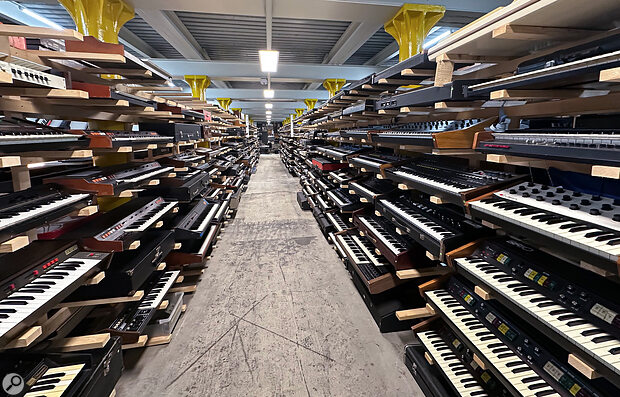From multifunctional army knives to chocolate, watches, banking, yodelling and (surprisingly) garlic presses, even the most exhaustive Python‑esque “What have the Swiss ever done for us?” list would be unlikely to include synth‑related stuff. Neighbouring France (Arturia, Daft Punk), Germany (Behringer, Kraftwerk), Italy (IK Multimedia) and even Austria (Falco) all have more well‑known links to electronic music than the inconspicuous town of Fribourg, nestled in a landlocked country of lakes and mountains.
But even if you get there, the guidebooks won’t help, and good luck finding the small sign in a huge industrial estate, before going down three floors in a lift, to a dust‑free, humidity‑controlled underground man‑cave — aka the Swiss Museum of Electronic Instruments, the synth wonder of the world.
My guide was Vic Genna, well versed in the art of watching people’s jaws drop as he narrates you through the floor‑to‑ceiling shelves stacked with over 5000 historic synths, drum machines, keytars, toys, pedals and computers. The kit is in immaculate condition too.
“As well as all the synths,” he explains, “we have a huge number of older organs. These are bulkier in terms of how much room they take up in our space. Although some of them connect to the birth of synthesis, such as the 1940s‑built Hammond Novachord, which was in fact technically the first polyphonic synth and has eight oscillators. The future of the rest of the organs is uncertain, but staff and volunteers here all have a say in what happens to the collection, what projects we get involved with, what becomes collectible, what doesn’t. It’s extremely democratic.”
Around 95 percent of the SMEM collection was founded by Basel collector Klemens Nikolaus Trenkle in the 1980s — he clearly bought everything at an advantageous time price‑wise, before acid house, dance music culture and later DAWless jamming inflated the prices. Working partly as a musical instrument dealer, in 2016 he co‑founded the SMEM ‘living museum’ and cultural concept.
SMEM isn’t just a heap of dusty relics in glass boxes. All the gear is lovingly restored, catalogued, learnt, used in collaborative projects and incorporated into established workshops and artist residencies.
You see, SMEM isn’t just a heap of dusty relics in glass boxes. All the gear is lovingly restored, catalogued, learnt, used in collaborative projects and incorporated into established workshops and artist residencies. Nothing encapsulates this more than the SMEM playroom, a living workshop and studio space separate to the larger store, where people can get hands on, experiment, record and collaborate.
The whole place is nothing short of miraculous, and unique in Europe. Most if not all of the big manufacturers (Roland, Korg, Yamaha and all the others) are apparently as jealous of this set up as you or I. Multiple versions of 808s, Wasps, Moogs, Prophets, and things you’ve never seen before from countries you’ve never visited are hanging around waiting for you to gawp at, touch, feel.
If you think about the hardware versus DAW history of electronic music, you’ll realise that this place is like an infinite VST library. Except every app/box here is the original physical artefact, with a fascinating authentic sound and haptic user interface that would teach modern app designers a thing or two.
But apart from all that, why do I love it? Well, you know how lovely, kind and well‑spirited all those people you’ve ever met who love synths and electronic music are? This is where they gather. This isn’t about superGAS, it’s a spiritual church of musical synthesis and a tribute to its creators — a sacred space for people who worship the god of synth to gather and celebrate; to live and breathe its future, present and past all in one go.
Yeah, all of that, in the country that brought you cheese with holes, and Heidi.
In fact, the Swiss love of craftsmanship, manufacturing, design, functionality, and most of all generosity of spirit, makes Switzerland the perfect home for such a thing. As awe‑inspiring and inspirational as the mountains and lakes themselves.

